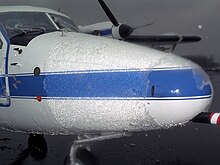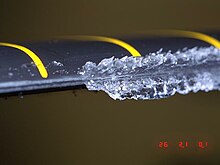| Revision as of 00:18, 28 February 2021 editSUM1 (talk | contribs)Autopatrolled, Extended confirmed users, Template editors36,928 edits →Accidents involving icing conditions: Added accident and converted to tableTag: 2017 wikitext editor← Previous edit | Revision as of 16:28, 12 April 2021 edit undoSUM1 (talk | contribs)Autopatrolled, Extended confirmed users, Template editors36,928 edits →Accidents involving icing conditions: Added entryTag: 2017 wikitext editorNext edit → | ||
| Line 78: | Line 78: | ||
| |9 January 1997 | |9 January 1997 | ||
| |] | |] | ||
| |- | |||
| |21 November 2004 | |||
| |] | |||
| |- | |- | ||
| |16 August 2005 | |16 August 2005 | ||
Revision as of 16:28, 12 April 2021
Atmospheric conditions that can lead to the formation of ice on aircraft surfaces and lead to substantial disturbance of the aerodynamics.
In aviation, icing conditions are atmospheric conditions that can lead to the formation of water ice on an aircraft. Ice accretion can affect the external surfaces of an aircraft – in which case it is referred to as airframe icing – or the engine, resulting in carburetor icing, air inlet icing or more generically engine icing. These phenomena do not necessarily occur together. Both airframe and engine icing have resulted in numerous fatal accidents in aviation history.
Not all aircraft, especially general aviation aircraft, are certified for flight into known icing (FIKI) – that is icing conditions certain or likely to exist, based on pilot reports, observations, and forecasts. In order to be FIKI-certified, aircraft must be fitted with suitable ice protection systems.
Definition
Icing conditions exist when the air contains droplets of supercooled liquid water; icing conditions are characterized quantitatively by the average droplet size, the liquid water content and the air temperature. These parameters affect the extent and speed that characterize the formation of ice on an aircraft. Federal Aviation Regulations contain a definition of icing conditions that some aircraft are certified to fly into. So-called SLD, or supercooled large droplet, conditions are those that exceed that specification and represent a particular hazard to aircraft.
Qualitatively, pilot reports indicate icing conditions in terms of their effect upon the aircraft, and will be dependent upon the capabilities of the aircraft. Different aircraft may report the same quantitative conditions as different levels of icing as a result. Ice detectors are used to indicate the presence of icing conditions.
Types of structural ice
| This section does not cite any sources. Please help improve this section by adding citations to reliable sources. Unsourced material may be challenged and removed. (December 2019) (Learn how and when to remove this message) |

- Clear ice is often clear and smooth. Supercooled water droplets, or freezing rain, strike a surface but do not freeze instantly. Often "horns" or protrusions are formed and project into the airflow. This form of ice is also called glaze.
- Rime ice is rough and opaque, formed by supercooled drops rapidly freezing on impact. Forming mostly along an airfoil's stagnation point, it generally conforms to the shape of the airfoil.
- Mixed ice is a combination of clear and rime ice.
- Frost ice is the result of water freezing on unprotected surfaces while the aircraft is stationary. This can be dangerous when flight is attempted because it disrupts an airfoil's boundary layer airflow causing a premature aerodynamic stall and, in some cases, dramatically increased drag making takeoff dangerous or impossible.
- SLD ice refers to ice formed in supercooled large droplet (SLD) conditions. It is similar to clear ice, but because droplet size is large, it extends to unprotected parts of the aircraft and forms larger ice shapes, faster than normal icing conditions. This was a factor in the crash of American Eagle Flight 4184.
Effect
| This section does not cite any sources. Please help improve this section by adding citations to reliable sources. Unsourced material may be challenged and removed. (December 2019) (Learn how and when to remove this message) |

The wing will ordinarily stall at a lower angle of attack, and thus a higher airspeed, when contaminated with ice. Even small amounts of ice will have an effect, and if the ice is rough, it can be a large effect. Thus an increase in approach speed is advisable if ice remains on the wings. How much of an increase depends on both the aircraft type and amount of ice. Stall characteristics of an aircraft with ice-contaminated wings will be degraded, and serious roll control problems are not unusual. The ice accretion may be asymmetric between the two wings. Also, the outer part of a wing, which is ordinarily thinner and thus a better collector of ice, may stall first rather than last.
Icing prevention and removal
Several methods exist to reduce the dangers of icing, using ice protection systems. The first, and simplest, is to avoid icing conditions altogether, but for many flights this is not practical.
If ice (or other contaminants) are present on an aircraft prior to takeoff, they must be removed from critical surfaces. Removal can take many forms:
- Mechanical means, which may be as simple as using a broom or brush to remove snow
- Application of deicing fluid or even hot water to remove ice, snow, etc.
- Use of infrared heating to melt and remove contaminants
- Putting the aircraft into a heated hangar until snow and ice have melted
- Positioning aircraft towards the Sun to maximize heating up of snow and ice covered surfaces. In practice this method is limited to thin contamination, by the time and weather conditions.
All of these methods remove existing contamination, but provide no practical protection in icing conditions. If icing conditions exist, or are expected before takeoff, then anti-icing fluids are used. These are thicker than deicing fluids and resist the effects of snow and rain for some time. They are intended to shear off the aircraft during takeoff and provide no inflight protection.

To protect an aircraft against icing in-flight, various forms of anti-icing or deicing are used:
- A common approach is to route engine "bleed air" into ducting along the leading edges of wings and tailplanes. The air heats the leading edge of the surface and this melts or evaporates ice on contact. On a turbine powered aircraft, air is extracted from the compressor section of the engine. If the aircraft is turbocharged piston powered, bleed air can be scavenged from the turbocharger.
- Some aircraft are equipped with pneumatic deicing boots that disperse ice build-up on the surface. These systems require less engine bleed air but are usually less effective than a heated surface.
- A few aircraft use a weeping wing system, which has hundreds of small holes in the leading edges and releases anti-icing fluid on demand to prevent the buildup of ice.
- Electrical heating is also used to protect aircraft and components (including propellers) against icing. The heating may be applied continuously (usually on small, critical, components, such as pitot static sensors and angle of attack vanes) or intermittently, giving an effect similar to the use of deicing boots.
In all these cases, usually only critical aircraft surfaces and components are protected. In particular, only the leading edge of a wing is usually protected.
Carburetor heat is applied to carbureted engines to prevent and clear icing. Fuel-injected engines are not susceptible to carburetor icing, but can suffer from blocked inlets. In these engines, an alternate air source is often available.
There is a difference between deicing and anti-icing. Deicing refers to the removal of ice from the airframe; anti-icing refers to the prevention of ice accumulating on the airframe.
Icing on unmanned aircraft
Unmanned aircraft are an emerging technology with a large variety of commercial and military applications. In-flight icing occurs during flight in supercooled clouds or freezing precipitation and is a potential hazard to all aircraft. In-flight icing on UAVs imposes a major limitation on the operational envelope. Unmanned aircraft are more sensitive and susceptible to icing compared to manned aircraft.
Accidents involving icing conditions
| This list is incomplete; you can help by adding missing items. (December 2019) |
| Date | Accident |
|---|---|
| 15 October 1943 | American Airlines Flight 63 (Flagship Missouri) |
| 13 January 1982 | Air Florida Flight 90 |
| 12 December 1985 | Arrow Air Flight 1285 |
| 10 March 1989 | Air Ontario Flight 1363 |
| 22 March 1992 | USAir Flight 405 |
| 31 October 1994 | American Eagle Flight 4184 |
| 9 January 1997 | Comair Flight 3272 |
| 21 November 2004 | China Eastern Airlines Flight 5210 |
| 16 August 2005 | West Caribbean Airways Flight 708 |
| 1 June 2009 | Air France Flight 447 |
| 9 January 2011 | Iran Air Flight 277 |
| 4 November 2010 | Aero Caribbean Flight 883 |
| 18 May 2011 | Sol Líneas Aéreas Flight 5428 |
| 24 July 2014 | Air Algérie Flight 5017 |
| 11 February 2018 | Saratov Airlines Flight 703 |
References
- Wadel, Mary (3 August 2017). "Airframe Icing". NASA Glenn Research Center. National Aeronautics and Space Administration. Retrieved 8 June 2019.
- Wadel, Mary (31 July 2017). "Engine Icing". NASA Glenn Research Center. National Aeronautics and Space Administration. Retrieved 8 June 2019.
- Yodice, John S. (1 August 2005). "The law on 'known icing'". Vol. 48, no. 8. AOPA Pilot Magazine. Archived from the original on 1 January 2015. Retrieved 25 April 2013.
{{cite magazine}}: Cite magazine requires|magazine=(help) - "Federal Aviation Regulations, Part 25, Appendix C". Archived from the original on 2012-03-19. Retrieved 2008-09-20.
- "Unsettled Topics in Unmanned Aerial Vehicle Icing (EPR2020008 Research Report) - SAE Mobilus". saemobilus.sae.org. doi:10.4271/epr2020008. Retrieved 2021-02-12.
External links
![]() Media related to Icing in aviation at Wikimedia Commons
Media related to Icing in aviation at Wikimedia Commons
- Aircraft Icing – NASA Page
- 14 CFR 25 Appendix C – Atmospheric Icing Conditions for Aircraft Certification